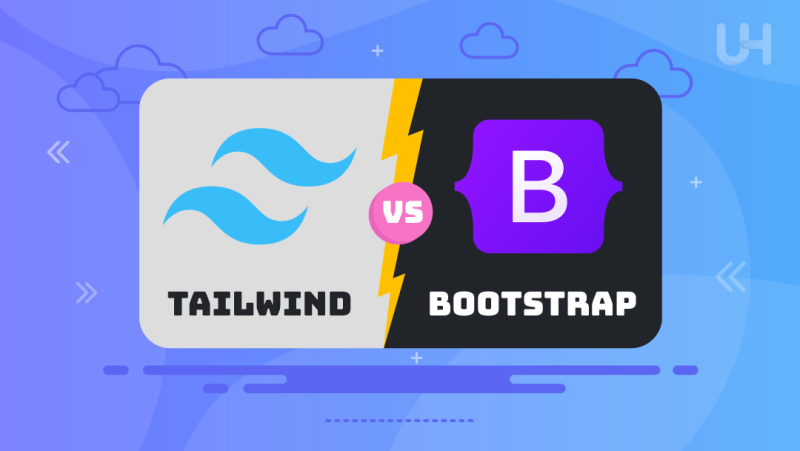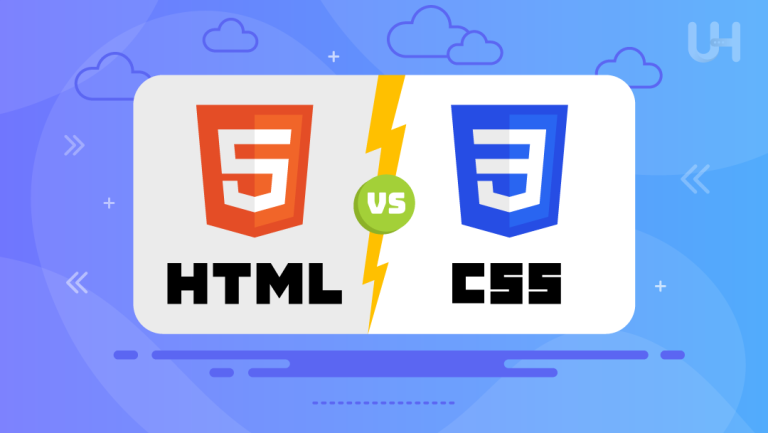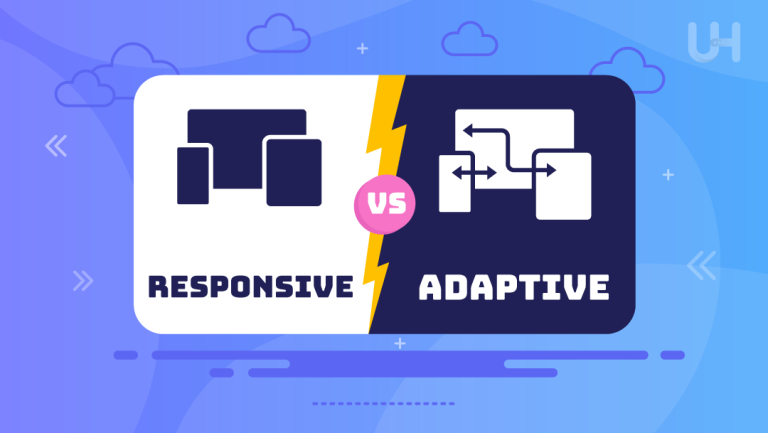While doing web development, selecting the right CSS framework makes a big difference and affects your workflow and the project’s result. Tailwind and Bootstrap are two famous CSS frameworks that rule today because of the pros offered to their developers and designers. Choosing between Tailwind vs Bootstrap is tricky, though mostly for the ones that have just started using any of the CSS frameworks or for those working on very specific project requirements. While both frameworks come with their powerful toolset, they differ in their design philosophy, flexibility, and customization.
In this article, we will examine the key differences between Tailwind vs Bootstrap. By reviewing each framework’s features and comparing their similarities and differences, you will be well-prepared to decide on the proper CSS framework for your next project.
What is Tailwind?
Tailwind CSS is a utility-first-oriented CSS framework that helps developers build user interface components at an incredible speed using a set of predefined utility classes. Other frameworks ship with pre-styled components, while by default, Tailwind offers a very customizable, low-level approach to styling. Instead of writing one-off custom classes for each occurrence, the developer can leverage Tailwind’s utility classes directly in their HTML markup to reach a highly customized design without having to write custom CSS from scratch.
Tailwind is popular with developers because it gives them flexibility and control over every detail of their design. It opens up much more granular paths to customization, making Tailwind the perfect fit for projects needing a unique or brand-specific look and feel. Tailwind allows you to create a fully custom design system from scratch without any involvement or reliance upon predefined styles or UI components.
Key Features and Benefits
Some of the strongest features of Tailwind are its utility-first approach and deep customization options. Among the key benefits it comes with are the following:
- Utility-first Approach: More than a thousand utility classes at your fingertips for margin, padding, color, and a lot of other properties that you directly apply to HTML elements. This means less custom CSS is required, and prototyping becomes faster.
- Customization and Extensibility: Tailwind is primarily extendable or customizable by a developer according to the project’s requirements. Users can use a configuration file to adjust colors, spacing, HTML fonts, and other design elements to match their brand identity.
- Responsive Design: Tailwind is built on the principles of mobile-first development. Its responsive utility classes make it easy to adjust things across different screen sizes and build layouts friendly to mobile devices.
- Modern Tooling Integration: It works well with build tooling like Webpack to handle your assets, clean up unused CSS, or optimize performance.
- No Predefined Components: Tailwind gives developers more freedom over how each element would look because this framework has no predefined components. This gives fuller flexibility in design.
What is Bootstrap?

Bootstrap is probably the most popular CSS framework developed by Twitter. It contains a set of pre-styled components, a responsive grid system, and classes that make faster development possible. The detailed component library goes from navigation bars to carousels, opening Bootstrap to rapid development for consistent and professional-looking websites. Bootstrap has so many predefined components and a great amount of documentation also makes it excellent for beginners and teams wanting to keep consistency in design between different pages.
The philosophy of Bootstrap is rapid prototyping and ease of use. The classes in Bootstrap framework are predefined, which enables one to pay more attention to the layout and functionality rather than the styles for each element. It is highly popular for creating prototypes and enterprise applications where consistency is key.
Key Features and Benefits
Bootstrap provides a whole range of benefits to developers by accelerating the pace of development. A few of the key advantages are:
- Predefined Components: Bootstrap has many pre-styled components available for buttons, forms, modals, dropdowns, etc. These can easily be customized for your web applications with the least development time.
- Responsive Grid System: Bootstrap’s grid system allows the creation of rapid, responsive, mobile-first layouts based on a 12-column layout. The framework provides many options for managing grid layouts on various screen sizes, from which responding designs are quite trivial to achieve.
- Cross-Browser Compatibility: The Bootstrap allows consistent web page maintenance across different browsers. This is especially helpful for developers while working on projects for the masses.
- Comprehensive Documentation: It has extensive documentation and an efficient community. New developers can get along with it quickly, and its robust documentation contributes to troubleshooting and understanding how to use components.
- Consistency Across Projects: This comes with pre-styled Bootstrap components to help maintain consistency. Hence, it is good for a large team or enterprise-level projects.
Tailwind vs Bootstrap: Similarities Explained
The purpose of Tailwind and Bootstrap is to ease the pain of styling for a web developer. Thinking and methodology differ totally, though. Here is a comparison on some significant aspects:
Utility Classes
Both frameworks provide utility classes useful for styling, such as spacing, color, and alignment. Tailwind goes much further, though, providing utilities for nearly every CSS property.
Responsive Design
By design, both Tailwind and Bootstrap are responsive, meaning it is relatively easy to change styles depending on the screen size. Bootstrap achieves this by using a grid system, while Tailwind achieves this by using responsive utility classes.
Prebuilt Components
Bootstrap contains some out-of-the-box components for modals, carousels, and navigation bars. On the other hand, Tailwind has minimal styling and does not provide prebuilt components out of the box, but it relies on utility classes.
Elevate Your Web Development Experience!
Are you ready to take your web development projects to the next level? With UltaHost’s reliable web hosting solutions, you can ensure your Tailwind or Bootstrap applications run smoothly and efficiently.
Customization
Highly customizable via its configuration file, Tailwind gives developers a lot of leeway in constructing unique design systems out of the box. While Bootstrap allows some level of customization, it’s more set up around its pre-defined components.
Cross-Browser Compatibility
Both frameworks ensure that their web application covers cross-browser compatibility so developers can create uniform user experiences across browsers.
Technology Integrations
Tailwind works well with most modern build tools, such as Webpack. Bootstrap can easily be used with several front-end libraries and frameworks, including Angular and React.
Community and Ecosystem
Both have huge supportive communities and a wealth of resources, tutorials, and plugins that extend development.
Bootstrap vs Tailwind: Comparing CSS Frameworks
While Bootstrap and Tailwind share similarities, they differ significantly in approach. Tailwind offers a more granular approach to styling through utility classes, while Bootstrap provides a comprehensive set of predefined components, making it especially well-suited for projects that benefit from quick setup and streamlined styling, like WordPress sites on WordPress VPS Hosting. Here’s a side-by-side comparison of Tailwind vs Bootstrap:
| Feature | Tailwind | Bootstrap |
| Approach | Utility-first | Component-based |
| Learning Curve | Moderate, requires CSS knowledge | Beginner-friendly |
| Customization | Extensive via configuration file | Limited to theme-based adjustments |
| Prebuilt Components | No, encourages custom design | Yes, wide selection available |
| Responsiveness | Mobile-first utility classes | Grid-based |
| Design Flexibility | Highly flexible, unique designs | Less flexible, uniform look |
| File Size | Smaller with unused CSS purge | Larger due to prebuilt components |
Tailwind vs Bootstrap: When To Use Each
Depending on your project requirements, either Tailwind or Bootstrap might be more suitable. Additionally, SEO VPS can further enhance your web development projects by optimizing your site for search engines.
Bootstrap
- Rapid Prototyping: Ideal for projects where speed is critical.
- Predefined Components: Great for websites that need a consistent, professional look.
- Ease of Learning: Best for beginners looking for a straightforward framework.
- Consistent Design Language: Suitable for corporate or enterprise projects where design consistency is vital.
Tailwind
- Agile Development: Excellent for projects needing a flexible design approach.
- Brand Consistency: Perfect for projects with specific branding requirements.
- Mobile Responsiveness: Allows for fine-tuning responsiveness using utility classes.
- Design Flexibility: Ideal for projects where unique, custom design is essential.
Conclusion
Whether to use Tailwind or Bootstrap depends on your project needs, design requirements, and your employees’ skills. Bootstrap has been tried and tested for rapid development, especially for people in need of an efficient solution with a consistent method of component-based design. Tailwind, however, guarantees flexibility and personalization at a whole new level, making it ideal for those developers who need to have complete dominion over the design. Whatever your choice, both Tailwind and Bootstrap have loads of features that can power up your development experience.
Utilizing a CSS framework like Tailwind or Bootstrap is key to creating efficient, visually appealing web applications. Enhance your development with UltaHost’s SSH VPS for secure access and complete control over your hosting environment.
FAQ
What’s the main difference between Tailwind and Bootstrap?
Tailwind is utility-first for customization, while Bootstrap has prebuilt components for quick design.
Which framework is better for responsive design?
Both support responsive design, but Tailwind offers finer control with utility classes.
Is Tailwind harder to learn than Bootstrap?
Tailwind can be more challenging initially, while Bootstrap is more beginner-friendly.
Can Tailwind and Bootstrap be used together?
Yes, you can, but choosing one is generally recommended to avoid code bloat and maintain a consistent design approach.
Which is more customizable: Tailwind or Bootstrap?
Tailwind allows full styling control, while Bootstrap is structured with preset components.
When should I choose Tailwind over Bootstrap?
Use Tailwind for custom designs and brand consistency and Bootstrap for faster prototyping.
How do tailwind bootstrap frameworks support agile development?
Tailwind’s utility classes offer flexible styling, while Bootstrap’s components speed up builds.













